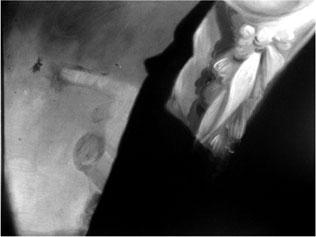 John Ritto Penniman John Ritto Penniman
Portrait of a Man, 1804
Technical Notes
The painting’s primary support is a plain-weave canvas. The original tacking edges are still attached, and selvage edges are extant on the top and bottom margins. Cusping is visible along all four edges. The canvas has been adhered with wax-resin adhesive to what appears to be a thin, plain-weave, fiberglass lining. The lining partially obscures the inscriptions on the back. There is a puncture in the lower left center of the background.
The warm white ground layer was thinly applied and does not hide the texture of the canvas. The paint was thinly applied wet-on-wet throughout the composition. The artist extended the contour of the proper left shoulder with a blue-black paint that is slightly darker than the rest of the coat. Significant changes in the composition are partially visible as pentimenti. The sitter was originally shown with his proper left hand pointing to something in the background at left center (fig.1). In addition to this change, Penniman painted over a long telescope-like object that appears as a pentimento just above the horizon line on the edge of the sitter’s proper right arm.
 |
 |
|
Figure 1. Infrared reflectogram showing changes to the background of Portrait of a Man.
|
There are retouched scattered pinpoint losses throughout. The retouching has discolored and no longer matches the original paint. There is solvent damage of varying degrees throughout the surface. Examination with ultraviolet light reveals that the right side of the coat still has an older natural resin surface coating, whereas the left side of the coat (which shows more solvent damage) does not. The current surface coatings are somewhat uneven.
Frame Notes
The frame consists of a gilded softwood molding of two-piece construction. The back members have through-mortise corner joints and the front pieces have mitered corners. The molding is a modified ogee profile with a central cove that has an applied, carved-wood, spiral ornament that is attached with small brads. On the inside of the raised edge are carved diamond grid patterns that angle in toward the center point of each member. The bole is a dark reddish-brown color. The back panel is finished with matte yellow paint. There is early hanging hardware on the back of the frame.
The frame is thought to be by John Doggett (1780–1857) of Roxbury, Massachusetts, from whom Penniman purchased frames and gold leaf and for whom he painted furniture, a shop sign, and glass tablets.1 Doggett was a frame and looking-glass maker, cabinetmaker, gilder, and carver with whom Penniman was closely associated from at least 1803 to 1807.2
Notes
1. John Doggett, Daybook, 1802–1809, Joseph Downs Collection of Manuscripts and Printed Ephemera, Winterthur Library, Winterthur, Delaware; and Andrews 1981, 149–50.
2. Cooper 1980a, 132–33; and Andrews 1981, 149. |